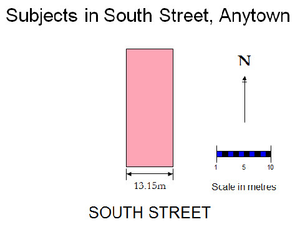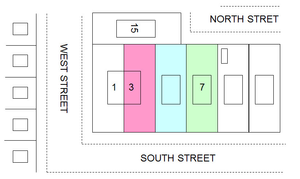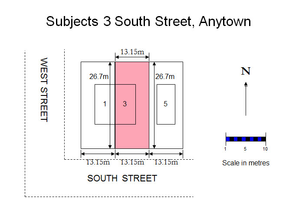Deed Plan Must Be Acceptable
When there DIR describes the extent of the property to be registered by reference to both a new plan annexed to the DIR and to a previously recorded deed, the extent is to be taken from the new plan annexed to the DIR.
Demonstrative Deed Plans - It is the Keeper's published policy that new deed plans "must not be stated to be demonstrative only and not taxative". While there are relatively few DIRs which contain this statement, or similar, if your application does contain such a statement, it should be referred to a referral officer for rejection.
New deed plans
Previously recorded or registered deed plans
Deed plans submitted to define the extent of a tenement steading
Deed plans used in combination with a verbal description of the foreshore "ex adverso" the subjects shown on the deed plan
Previously recorded or registered deeds with plans and referring to parcel or field numbers
Exceptions
1 Property is seabed
If your application is to register an area of seabed in the registration county of SEA, special requirements exist. See Further Guidance Description of Seabed Plot Must Be Acceptable.
2 Lease of part of a tenement
If your application is to register a lease of part of a tenement, there is an exception to the normal policy that can be applied if the lease contains a verbal description AND refers to a plan. If the plan showing the leased premises does not meet the keeper’s requirements for mapping, we can treat the reference to the plan as pro non scripto and work solely with the verbal description of the leased premises. This is only possible because of the keeper’s policy of incorporating the whole of the lease deed (with any plans) into the title sheet by reference to the deed in the archive record, since the information contained in the lease plans is not “lost” when the keeper uses only the verbal description. This exception to normal policy must only be applied to this scenario of leases within tenements (and an associated APR application) – not to non-tenement leases, and not to ownership titles within tenements.
It must be stressed, however, that the keeper can only proceed on the basis of the verbal description if that verbal description is acceptable. The external general guidance on the cadastral map relating to tenements and other flatted buildings states that where the keeper already holds an extent for the tenement steading, the applicant should ensure that that their application/deed is clear about the location [within the tenement] of the flat or unit with which they are dealing. See Further Guidance page Description of Flatted Property Must Be Acceptable for details of what constitutes an acceptable verbal description.
3 Lease plans showing detail other than the extent of the leased premises
Often in a lease, or variation of lease, as well as the plan showing the extent of the leased premises, there will be additional plans annexed to the deed that show leasehold conditions (for example, rights of access in favour of the tenant, extent of the landlord's larger subjects, etc). As the keeper will only be mapping the extent of the leased premises, and will not be providing plans references for the leasehold conditions (see Mapping Leases for guidance on the keeper's policy on preparing lease title sheets), there is no requirement for those additional plans to meet the deed plan criteria set out, above.
4 Voluntary registration
It is acceptable for a voluntary registration application to use digital data as an alternative to paper based plans and deeds. With voluntary registrations the application may or may not include the paper deeds or they may not contain sufficient information to identify the location and extent of the property. In this scenario, the submitting agent may choose to submit plans information in digital format. In this case, a PDF of the plan is also required. The extent of the subjects can be mapped using the digital data along with the PDF for visual representation. The PDF is essential to ensure that the digital data accurately represents the property being registered.
Registers of Scotland (RoS) seeks to ensure that the information published in the 2012 Act Registration Manual is up to date and accurate but it may be amended from time to time.
The Manual is an internal document intended for RoS staff only. The information in the Manual does not constitute legal or professional advice and RoS cannot accept any liability for actions arising from its use.
Using this website requires you to accept cookies. More information on cookies.
Feedback


